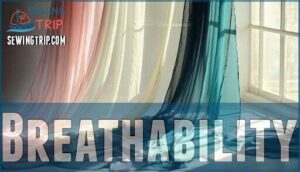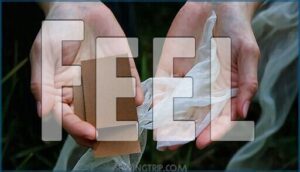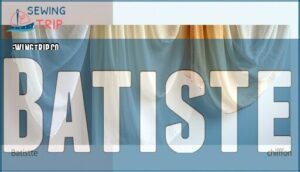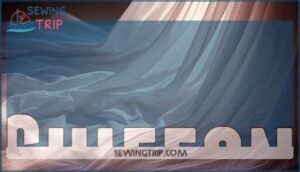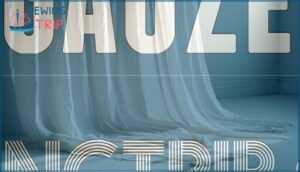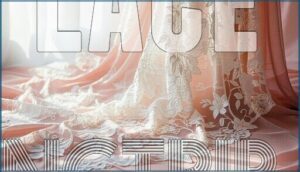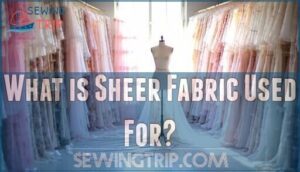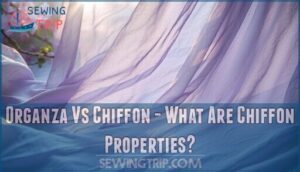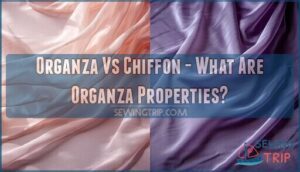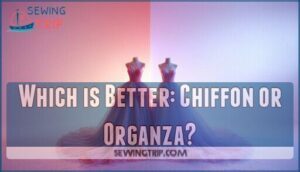This site is supported by our readers. We may earn a commission, at no cost to you, if you purchase through links.
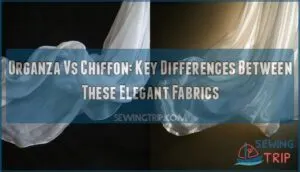 When you’re choosing between these elegant fabrics, the organza vs chiffon difference comes down to structure and flow.
When you’re choosing between these elegant fabrics, the organza vs chiffon difference comes down to structure and flow.
Organza feels crisp and papery with a slight sheen that holds its shape like a well-pressed shirt.
It’s your go-to for structured pieces that need volume and definition.
Chiffon, however, drapes like liquid silk with a soft, slightly rough texture that moves naturally with your body.
Think of organza as the backbone of formal wear and chiffon as the graceful flowing element.
Both are sheer, but organza stands firm while chiffon whispers with every movement.
The choice depends on whether you need structure or fluidity for your project.
Table Of Contents
- Key Takeaways
- What is Organza and Chiffon?
- What is Sheer Fabric Made Of?
- What is Sheer Fabric Used For?
- Organza Vs Chiffon – What Are Chiffon Properties?
- Organza Vs Chiffon – What Are Organza Properties?
- What is Organza Used For?
- Which is Better: Chiffon or Organza?
- Frequently Asked Questions (FAQs)
- Conclusion
Key Takeaways
- Organza is crisp and stiff, making it great for structured and voluminous designs. Chiffon is soft, flowy, and perfect for romantic outfits.
- Organza works best for bold silhouettes while chiffon excels in gentle draping and softer effects.
- Chiffon is more breathable and better for warm weather, while organza’s stiffness adds layering potential for cooler conditions.
- Organza is pricier and requires more maintenance, while chiffon offers affordable, lightweight elegance but is more delicate over time.
What is Organza and Chiffon?
Organza and chiffon are both sheer fabrics, but they couldn’t be more different in texture and structure.
While organza is crisp and stiff, chiffon is lightweight and flowing, making each fabric suited for unique designs and purposes.
Appearance
Both organza and chiffon bring elegance and transparency to your wardrobe, but they couldn’t be more different in texture and visual impact.
Organza wows with its crisp texture, polished sheen, and ability to hold dramatic shapes, while chiffon enchants with its soft drape, subtle matte finish, and flowing elegance.
Creating memorable fashion moments means choosing fabrics that reflect your vision—structured drama or flowing romance.
If you’re after structure and bold volume, organza delivers. For a romantic, ethereal touch, chiffon is your winner.
Here’s how they shine:
- Sheerness comparison: Organza is ultra-sheer, while chiffon provides slightly more opacity.
- Texture contrast: Organza feels crisp and stiff; chiffon is smooth and airy.
- Drape variations: Organza creates bold silhouettes; chiffon flows gently for a softer effect.
Each fabric adds unique sophistication to your look. For similar applications, one might consider breathable voile options.
Durability
When comparing durability, the tightly woven structure of organza fabric gives it better tear resistance than chiffon fabric.
However, organza’s stiffness can make it susceptible to snags. Chiffon’s looser weave offers softness but increases snag susceptibility, particularly with silk variants.
Synthetic variants of both, like polyester, boost durability and lower fabric maintenance. While chiffon is favored for flowing garments, voile offers structure.
If you’re after long-lasting wear, weigh your priorities: organza excels in strength and structure, while chiffon offers a lighter yet more delicate option. Both fabrics demand care, but their beauty is worth the effort.
Breathability
Breathability varies depending on weave density and fiber choice.
Chiffon fabric excels in warmer weather with its airy, lightweight feel and moisture-wicking properties, keeping your body temperature in check.
Organza fabric, though slightly heavier, allows airflow through its sheer weave, balancing comfort and structure.
One advantage of polyester chiffon is that it resists sweat stains, which is a significant benefit for warm weather clothing.
If sheer fabrics are part of your wardrobe, this fabric comparison highlights chiffon’s comfort level and organza’s crispness, ensuring you stay cool yet elegant in any setting.
Fit and Drape
When talking about how fabric drapes, organza and chiffon couldn’t be more different.
Organza offers a structured fit, holding dramatic, voluminous shapes—great for skirts or layered designs. Chiffon, however, boasts a soft, flowy design, making it perfect for elegant, ethereal outfits.
Here’s a quick comparison to help you:
- Fabric drape: Organza stays crisp and firm, while chiffon flows gently.
- Silhouette impact: Chiffon hugs lightly; organza adds bold, sculptural volume.
- Layering effects: Chiffon’s softness works under layers; organza shines as the statement.
- Structured garments: Need drama? Organza. Want softness? Chiffon.
Each fabric brings unique charm to your wardrobe staples!
Understanding how grain lines affect drape is essential for achieving the desired effect.
Feel
In the context of the feel of fabric, every detail matters.
When choosing fabric, every texture tells a story—and yours should feel just right.
Chiffon offers softness that whispers against your skin, creating a light, airy sensory experience perfect for flowy dresses and romantic styles.
Its delicate texture, combined with subtle sheen, feels like wearing a gentle breeze.
In contrast, organza provides a crisp, structured feel with a touch of elegance.
Its firm texture mightn’t glide as smoothly on your skin, but it excels in adding drama and sharpness to your look.
Here’s a quick comparison:
| Fabric Hand | Chiffon | Organza |
|---|---|---|
| Softness | High | Moderate |
| Crispness | Low | High |
| Comfort Level | Very comfortable | Slightly firm |
| Skin Contact | Smooth and flowy | Stiff but lightweight |
| Sensory Feel | Breezy, delicate | Structured, polished |
Both fabrics create unique impressions that make your outfit unforgettable.
What is Sheer Fabric Made Of?
Sheer fabrics like organza and chiffon are crafted from a variety of materials, including silk, polyester, and nylon. Each material impacts the fabric’s texture, durability, and overall appearance.
Batiste
Batiste offers a lightweight feel with a soft, smooth texture, making it perfect for both style and comfort.
Unlike organza’s stiffness or chiffon’s airy flow, it balances flexibility with structure. Batiste shines in delicate summer outfits, lingerie, and home decor.
- Batiste Characteristics: Semi-sheer with a crisp finish.
- Batiste Uses: Dresses, blouses, curtains.
- Batiste vs Chiffon: Less flowy, softer texture.
- Batiste Maintenance: Easy to care for, often machine washable.
Chiffon
Chiffon is one of those fabrics that feels almost weightless, making it a favorite for summer dresses, flowy blouses, and evening wear.
Typically made from silk, polyester, or nylon, chiffon combines elegance with versatility. Its light, airy weave allows the fabric to drape beautifully, and its natural sheerness makes layering a breeze.
Synthetic chiffon is more durable and budget-friendly, while silk chiffon adds luxury.
To understand chiffon better, here’s a quick breakdown:
| Feature | Explanation |
|---|---|
| Textures | Soft, slightly rough due to tightly twisted yarns. |
| Durability | Silk is delicate; synthetics offer longer wear. |
| Sheerness | Light passes through, creating a dreamy effect. |
| Cost | Silk chiffon is pricey; synthetics are affordable. |
Whether for elegant ruching or cascading overlays, chiffon’s versatility guarantees it always shines.
Georgette
Georgette’s charm lies in its sheer elegance and versatility. Made from silk, polyester, or cotton, this fabric is lightweight, durable, and slightly grainy in texture, offering a sophisticated yet practical option for fashion.
Its fluid drape works wonders for garments like blouses, dresses, and skirts.
- Georgette Durability: Though delicate in appearance, it holds up well for frequent use.
- Georgette Texture: The subtle grainy feel adds uniqueness and softness.
- Georgette Cost: More affordable in synthetic options but luxurious in silk.
Unlike chiffon’s smooth texture or organza’s stiffness, georgette strikes a balance between elegance and everyday wear. It’s a graceful winner for flowing yet structured designs.
Gauze
Gauze, a breezy, lightweight fabric, is frequently made from silk, cotton, or polyester.
Its open weave and airy texture make it perfect for summer garments, baby clothes, or even curtains.
Known for its soft drape and breathability, gauze adds a natural, relaxed charm to your wardrobe.
You’ll find its versatility impressive, as it dyes easily into vibrant colors.
Although less structured than organza or chiffon, it offers comfort and simplicity.
For delicate fabrics, gauze alternatives include chiffon or batiste.
Lace
If you thought gauze was the go-to sheer fabric for light, breezy designs, lace takes elegance up a notch.
Known for its intricate patterns and delicate artistry, lace transforms any garment into a showstopper.
Its origins trace back to centuries-old embroidery techniques on lightweight materials, offering both beauty and flexibility.
Whether it’s vintage lace with timeless charm or modern styles crafted from synthetic fibers, there’s something magical about this sheer fabric.
From wedding dress fabric that shines with sophistication to overlays on evening gowns and home décor accents, lace doesn’t hold back.
Its durability varies by type, and while it’s pricier than some fabrics like chiffon, its character justifies the cost.
Organza might be bold, but lace whispers grace.
What is Sheer Fabric Used For?
Sheer fabric is versatile, adding elegance to garments, decor, and crafts.
Its transparent nature shines in several ways:
- Clothing: Perfect for wedding gowns, evening wear, and lightweight blouses, sheer fabric like organza or chiffon brings sophistication.
- Home Decor: Delicate sheers transform spaces with soft curtains or table accents, offering charm and light diffusion.
- Creative Crafts: From sheer fabric art to DIY projects, you can explore accessories or intricate designs effortlessly.
With its timeless allure, sheer fabric never goes out of style.
Organza Vs Chiffon – What Are Chiffon Properties?
Chiffon is loved for its lightweight, airy charm, and versatility. Its sheerness adds elegance without heaviness, making it a go-to for layering.
The fabric’s flow and soft drape create a graceful silhouette, perfect for dresses or scarves. Chiffon’s texture feels smooth, almost like a soft breeze against your skin.
| Property | Description | Benefit |
|---|---|---|
| Sheerness | Transparent yet modest | Perfect for layers |
| Drape | Fluid and soft | Enhances flowy designs |
| Weight | Minimal, feather-light | Comfortable and breathable wear |
Take care: hand-wash gently!
Organza Vs Chiffon – What Are Organza Properties?
Organza stands out with its crisp texture, lightweight feel, and sheer elegance.
Its stiffness and structured drape make it ideal for formal dresses, adding volume and definition.
Though breathable, organza’s slightly rough touch may feel itchy on sensitive skin.
Curious about how it compares? Let’s break it down:
| Property | Organza | Chiffon |
|---|---|---|
| Texture | Crisp, slightly coarse | Smooth, slippery |
| Weight | Lightweight | Lightweight |
| Drape | Stiff, structured | Flowing, soft |
| Sheerness | Very transparent | Slightly opaque |
Choosing between organza vs chiffon depends on the look and structure you need!
What is Organza Used For?
Organza shines as a go-to bridal fabric, loved for creating structured designs like wedding veils, evening gowns, and statement sleeves.
Its crisp texture adds elegance to layered bridal wear, while its stiffness makes it ideal for voluminous skirts and structured garments that hold their shape beautifully.
Beyond fashion, organza uses extend to decorations, including delicate table runners and chic chair sashes for formal events.
Many brides choose an organza wedding veil for their special day, and with its versatility, organza transforms anything it touches into a polished, graceful statement.
Which is Better: Chiffon or Organza?
Choosing between organza and chiffon depends on what suits your needs best.
Organza’s crisp texture and structured shape make it a favorite for formal gowns and bold designs.
It holds its shape firmly, which is ideal for dramatic skirts or statement sleeves.
On the other hand, chiffon’s flowy drape and soft texture are perfect for airy, romantic outfits like evening dresses or summer shawls.
When it comes to cost, chiffon is typically more affordable, especially synthetic versions.
Organza, often made from silk, tends to be pricier and needs more care.
For seasonal comfort, chiffon is better in warmer months due to its breathability, while organza works well in cooler weather for its layering potential.
Ultimately, the organza vs chiffon choice comes down to user preference, design suitability, and the fabric’s Best Uses.
Frequently Asked Questions (FAQs)
What is better, chiffon or organza?
Neither fabric’s inherently "better" – it depends on your project’s needs. You’ll love chiffon’s soft drape for flowing dresses, while organza’s crisp structure works beautifully for formal gowns and structured designs.
What are the disadvantages of organza fabric?
You’ll find organza challenging to work with due to its stiff, scratchy texture that can irritate skin.
It requires expensive dry cleaning, tears easily despite stiffness, and wrinkles readily, making maintenance costly and time-consuming.
What are the disadvantages of chiffon fabric?
Chiffon can be tricky to handle since it snags easily and wrinkles fast.
Its delicate, lightweight weave makes it prone to tearing, and maintaining it requires gentle care—like washing it cold and air-drying.
Does organza hold its shape?
Think of organza as a disciplined student—it’s stiff and crisp, so it holds its shape beautifully.
Its structure makes it perfect for formal wear like voluminous skirts, veils, or custom, statement-making details, with voluminous being a key characteristic of its use.
What is the difference in weight between organza and chiffon?
Organza weighs more because it’s tightly woven and has a stiffer structure, while chiffon is lightweight and airy.
You’ll notice organza feeling crisp and firm, whereas chiffon feels soft, flowy, and almost feather-like.
What is the difference in opacity between organza and chiffon?
You’ll notice that organza is more transparent, almost like a crisp spiderweb, while chiffon is slightly more opaque, offering a soft, dreamy veil-like appearance.
Both are sheer but reveal in distinct, stylish ways, with sheer being a key characteristic that defines their unique visual impact.
How does the cost of organza and chiffon fabrics compare?
If you’re eyeing these fabrics, brace yourself for a price gap.
Organza’s silk composition makes it pricier and exclusive, while chiffon’s synthetic options keep it affordable.
Your wallet decides whether it’s luxury or practicality!
How do organza and chiffon fabrics hold up over time?
Organza’s tight weave makes it durable, keeping its crispness, but it’s prone to fraying.
Chiffon’s looser weave feels soft and airy, though it’s more delicate, easily snagging over time.
Both need gentle care to last.
Can organza and chiffon be dyed at home?
Dyeing organza or chiffon feels like painting on fragile glass—possible but tricky.
Use fabric dye for polyester or silk, test a small piece first, and handle gently to avoid uneven coloring or damage.
How do you remove wrinkles from chiffon?
To remove wrinkles from chiffon, gently steam it or use an iron on the lowest heat setting with a pressing cloth.
Avoid direct heat to prevent damage, and let it cool before handling, as this will help preserve the fabric’s integrity and prevent damage.
Conclusion
Choosing between organza and chiffon is like picking between vinyl and streaming music—both have unique charm depending on your needs.
Organza’s crisp structure is ideal for pieces that require volume, while chiffon’s soft drape creates effortless elegance.
Understanding the organza vs chiffon difference helps you decide which fabric aligns with your vision.
Whether you’re crafting structured formal wear or flowing gowns, both excel in their own way, ensuring your project stands out with grace or grandeur.



